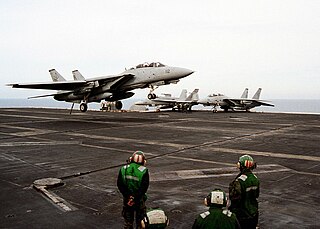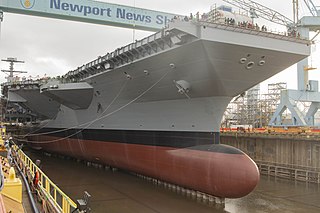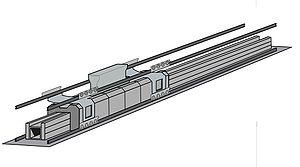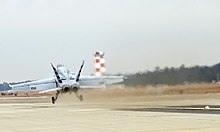
An aircraft carrier is a warship that serves as a seagoing airbase, equipped with a full-length flight deck and facilities for carrying, arming, deploying, and recovering aircraft. Typically, it is the capital ship of a fleet, as it allows a naval force to project air power worldwide without depending on local bases for staging aircraft operations. Carriers have evolved since their inception in the early twentieth century from wooden vessels used to deploy balloons to nuclear-powered warships that carry numerous fighters, strike aircraft, helicopters, and other types of aircraft. While heavier aircraft such as fixed-wing gunships and bombers have been launched from aircraft carriers, these aircraft have not landed on a carrier. By its diplomatic and tactical power, its mobility, its autonomy and the variety of its means, the aircraft carrier is often the centerpiece of modern combat fleets. Tactically or even strategically, it replaced the battleship in the role of flagship of a fleet. One of its great advantages is that, by sailing in international waters, it does not interfere with any territorial sovereignty and thus obviates the need for overflight authorizations from third-party countries, reduces the times and transit distances of aircraft and therefore significantly increases the time of availability on the combat zone.

USS George H.W. Bush (CVN-77) is the tenth and final Nimitz-class supercarrier of the United States Navy. She is named for the 41st President of the United States and former Director of Central Intelligence George H. W. Bush, who was a naval aviator during World War II. The vessel's callsign is Avenger, after the TBM Avenger aircraft flown by then-Lieutenant George H. W. Bush in World War II. Construction began in 2003 at Northrop Grumman, in Newport News, Virginia and was completed in 2009 at a cost of $6.2 billion. Her home port is Naval Station Norfolk, Virginia.

The Nimitz class is a class of ten nuclear-powered aircraft carriers in service with the United States Navy. The lead ship of the class is named after World War II United States Pacific Fleet commander Fleet Admiral Chester W. Nimitz, who was the last living U.S. Navy officer to hold the rank. With an overall length of 1,092 ft (333 m) and a full-load displacement of over 100,000 long tons (100,000 t), the Nimitz-class ships were the largest warships built and in service until USS Gerald R. Ford entered the fleet in 2017.

USS Enterprise (CVN-65), formerly CVA(N)-65, is a decommissioned United States Navy aircraft carrier. In 1958, she was the first nuclear-powered aircraft carrier and the eighth United States naval vessel to bear the name. Like her predecessor of World War II fame, she is nicknamed "Big E". At 1,123 feet (342 m), she is the longest naval vessel ever built and the only ship of a class that was originally planned to have five other ships. Her 93,284-long-ton (94,781 t) displacement ranks her class as the third-heaviest carrier class, after the Nimitz class and the Gerald R. Ford class. Enterprise had a crew of some 4,600 service members.

An electromagnetic catapult, also called EMALS after the specific US system, is a type of aircraft launching system. Currently, only the United States and China have successfully developed it, and it is installed on the Gerald R. Ford-class aircraft carriers and the Chinese aircraft carrier Fujian. The system launches carrier-based aircraft by means of a catapult employing a linear induction motor rather than the conventional steam piston.

The Gerald R. Ford-class nuclear-powered aircraft carriers are currently being constructed for the United States Navy, which intends to eventually acquire ten of these ships in order to replace current carriers on a one-for-one basis, starting with the lead ship of her class, Gerald R. Ford (CVN-78), replacing Enterprise (CVN-65), and later the Nimitz-class carriers. The new vessels have a hull similar to the Nimitz class, but they carry technologies since developed with the CVN(X)/CVN-21 program, such as the Electromagnetic Aircraft Launch System (EMALS), as well as other design features intended to improve efficiency and reduce operating costs, including sailing with smaller crews. This class of aircraft carriers is named after former U.S. President Gerald R. Ford. CVN-78 was procured in 2008 and commissioned into service on 22 July 2017. The second ship of the class, John F. Kennedy (CVN-79), is scheduled to enter service in 2025.

STOBAR is a system used for the launch and recovery of aircraft from the deck of an aircraft carrier, combining elements of "short take-off and vertical landing" (STOVL) with "catapult-assisted take-off but arrested recovery" (CATOBAR).

An aircraft catapult is a device used to allow aircraft to take off in a limited distance, typically from the deck of a vessel. They can also be installed on land-based runways, although this is rarely done. They are usually used on aircraft carriers as a form of assisted take off.

The A1B reactor is an aircraft carrier nuclear reactor developed by the United States Navy. It is used in Gerald R. Ford-class aircraft carriers to provide electrical and propulsion energy. The A1B is the first naval reactor produced by Bechtel Corporation, which has "performed engineering and/or construction services on more than 80 percent of [land-based] nuclear plants in the United States".

Lakehurst Maxfield Field, formerly known as Naval Air Engineering Station Lakehurst, is the naval component of Joint Base McGuire–Dix–Lakehurst, a United States Air Force-managed joint base headquartered approximately 25 mi (40 km) east-southeast of Trenton in Manchester Township and Jackson Township in Ocean County, New Jersey, United States. It is primarily the home to Naval Air Warfare Center Aircraft Division Lakehurst, although the airfield supports several other flying and non-flying units as well. Its name is an amalgamation of its location and the last name of Commander Louis H. Maxfield, who lost his life when the R-38/USN ZR-2 airship crashed during flight on 24 August 1921 near Hull, England.

An arresting gear, or arrestor gear, is a mechanical system used to rapidly decelerate an aircraft as it lands. Arresting gear on aircraft carriers is an essential component of naval aviation, and it is most commonly used on CATOBAR and STOBAR aircraft carriers. Similar systems are also found at land-based airfields for expeditionary or emergency use. Typical systems consist of several steel wire ropes laid across the aircraft landing area, designed to be caught by an aircraft's tailhook. During a normal arrestment, the tailhook engages the wire and the aircraft's kinetic energy is transferred to hydraulic damping systems attached below the carrier deck. There are other related systems that use nets to catch aircraft wings or landing gear. These barricade and barrier systems are only used for emergency arrestments for aircraft without operable tailhooks.

USS Gerald R. Ford (CVN-78) is an aircraft carrier for the United States Navy and the lead ship of her class. The ship is named after the 38th President of the United States, Gerald Ford, whose World War II naval service included combat duty aboard the light aircraft carrier Monterey in the Pacific Theater.

USS John F. Kennedy (CVN-79) is the second Gerald R. Ford-class aircraft carrier built for the United States Navy. The ship was launched on 29 October 2019, and christened on 7 December 2019.

CATOBAR is a system used for the launch and recovery of aircraft from the deck of an aircraft carrier. Under this technique, aircraft launch using a catapult-assisted take-off and land on the ship using arrestor wires.

The Northrop Grumman X-47B is a demonstration unmanned combat aerial vehicle (UCAV) designed for aircraft carrier-based operations. Developed by the American defense technology company Northrop Grumman, the X-47 project began as part of DARPA's J-UCAS program, and subsequently became part of the United States Navy's Unmanned Combat Air System Demonstration (UCAS-D) program. The X-47B is a tailless jet-powered blended-wing-body aircraft capable of semi-autonomous operation and aerial refueling.

USS Enterprise (CVN-80) will be the third Gerald R. Ford-class aircraft carrier to be built for the United States Navy. She will be the ninth United States naval vessel and third aircraft carrier to bear the name, and is scheduled to be in operation by 2028. Her construction began in August 2017 with a steel-cutting ceremony.

The Advanced Arresting Gear (AAG) is a type of arresting gear developed by General Atomics for the U.S. Navy's newest Gerald R. Ford-class aircraft carriers. It was deployed in 2017 on the lead ship of the class, the USS Gerald R. Ford (CVN-78).



















